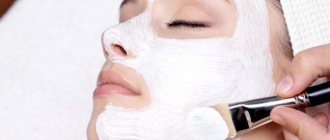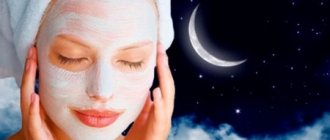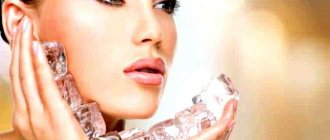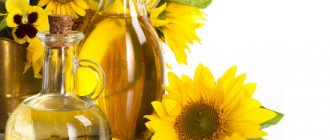Signs of skin dehydration
First, make sure you don't confuse dry skin with dehydrated skin. Yes, these are different states.
Dryness is a constant characteristic of the skin and has genetic causes.
Dehydration is a specific condition of any skin type (including oily) caused by a lack of moisture.
Dehydrated skin is in a state of drought. © iStock
You can understand that the skin is experiencing strong thirst on your own, focusing on subjective sensations and visual parameters. Here are the most obvious signs.
A feeling of tightness after contact with water : after washing, you want to quickly apply cream to relieve discomfort.
Rough surface - if no action is taken, peeling may appear on the face, which characterizes extreme dehydration.
Dehydration lines are small wrinkles that appear both in areas with active facial expressions and throughout the face. Disappears immediately after applying the cream.
Dehydration is easy to notice: if you gather the skin into a fold (for example, with your fingers, push the skin up in the cheekbone area) or smile broadly, small grooves appear in the area around the eyes.” Elena Eliseeva, medical expert at Vichy
Dry facial skin. Rules for caring for problem areas
Dry facial skin, what to do and how to remove this unpleasant phenomenon? Dry skin types require constant and especially careful care. In order to soften and moisturize the unwanted effects of dryness, you must follow some not very complicated rules:
- You only need to wash your face with cleansers in the evening, because if you wash off all the fat from the surface of the skin in the morning, it will remain unprotected from external negative factors.
- The water for washing should not be too hot or too cold; it is much better to give preference to room temperature. Settled, cooled, boiled or filtered water is especially good for washing.
- When choosing cosmetic products for the care of dry skin, pay attention to those that do not contain alcohol or any acid, because alcohol is known to be very drying to the skin.
- Be sure to make moisturizing and nourishing face masks 2-3 times a week.
- It is necessary to use decorative cosmetics, such as powder or foundation, very wisely and it is advisable to overload the skin with such products as little as possible.
- When choosing a cream or cleanser, carefully check that it suits your specific dry skin type.
- After washing, you should not rub your face too much with a towel; it would be better to just gently blot the remaining water from the skin.
- Include as much liquid as possible in your diet. Popular wisdom says: drink water before meals, you will be forever young.
- Try to allow fresh air to enter the room; do not forget to ventilate the room in which you are staying for a long time.
Dehydration of facial skin: causes and symptoms
Most often, dehydration is caused by a violation of the integrity of the hydrolipid mantle. It ceases to cope with its functions and cannot retain moisture in the skin. Several factors can provoke this.
READ ALSO: Rash due to mononucleosis in children and adults: features and treatment
Environment
This includes not only extreme weather conditions, but also excessively dry air in rooms with central heating and air conditioning. The skin is forced to compensate for the lack of moisture from the outside with its own water resources, which are quickly depleted.
Improper care
aggressive cleansing (especially often used in the case of oily and combination skin);
incorrectly selected cleansers and makeup removers;
cosmetics that do not match your skin type, season or circumstances.
All this weakens the hydrolipid barrier, and moisture begins to evaporate rapidly.
Improper care dehydrates the skin. © iStock
Dehydration of the body
Now remember how much water you drink during the day? Insufficient fluid intake leads to dehydration of the body in general and the skin in particular. The average norm is 1.5 liters (coffee, tea, compote and juice do not count).
Age-related changes
With age, the synthesis of its own hyaluronic acid and moisture is redistributed: the maximum amount is in the dermis, and the epidermis receives the remainder. This is associated with the feeling of tightness after cleansing with water. And this, by the way, is one of the first signs of aging.
Care for dehydrated skin
To restore the moisture level of any skin type, you will have to strictly inspect the quality of care.
READ ALSO: Alginate mask: what it does, what it’s for and how to use
Cosmetics with a high acid content.
Washing with cold and/or hot water.
Moisturizing serums and concentrates will help quickly restore the moisture level of the epidermis. Apply them twice a day immediately after cleansing, before applying cream (but not instead of it).
Hydro-Plumping Re-Texturizing Serum Concentrate, Kiehl's, contains 15% vegetable glycerin. where to find?
Hydrating B5 intensive moisturizing gel, SkinCeuticals, contains low molecular weight hyaluronic acid and vitamin B5. where to find?
moisturizing masks, sheet or gel, daily for two weeks until the skin recovers. Then switch to a regimen of 1-2 times a week.
Super-moisturizing and toning fabric mask “Aquabomb”, Garnier, is impregnated with hyaluronic acid and pomegranate extract. where to find?
Night SPA care Aqualia Thermal, Vichy, with oils and hyaluronic acid can be applied in a thick layer and used as a mask at night. where to find?
moisturizing creams based on your skin type and apply twice a day to saturate the epidermis with moisture and retain it throughout the day.
Dehydrated skin
When you explain to someone, you understand better yourself. The post is an attempt to break down the topic of dehydration. Relevant for those who have accumulated a cart and a small cart of inappropriate moisturizing and nourishing creams.
And I will immediately separate the concepts of “skin type” and “skin condition”. Skin type is how much sebum it produces. It can be: dry, combination prone to dryness, normal, combined prone to oily, oily. It is believed that the tendency towards one type or another is genetic. Skin conditions are the problems that we acquire (age-related changes, dehydration, pigmentation, acne, sensitivity, etc.) So, speaking of dehydration, we are talking about a condition that can be relevant for any skin type.
To make it easier to navigate further, let me remind you of the structure of the skin:
The water content in the epidermis is distributed unevenly. In the basal layer it is about 70%, and in the stratum corneum it is about 15%. Water continuously passes through all layers of the epidermis and evaporates from the surface of the stratum corneum. This process is normal and is called transepidermal water loss, TEWL (according to international standards, TEWL - transepidermal waterloss). But moisture loss increases due to a violation of the protective functions of the skin and depends on humidity, temperature, time of year, and the total water content in the skin. When they talk about disruption of the protective functions of the skin, they mean disruption of the moisture-retaining structures that are located in the stratum corneum. Therefore, when they talk about moisturizing, they mean moisturizing the stratum corneum of the skin, and all moisturizers work with it.
Water-retaining structures of the skin:
• Sebum – smoothes the horny scales, reducing the area of contact between the intercellular spaces with air (the surface from which evaporation occurs is reduced); creates an additional water-repellent layer on the surface of the skin, preventing water evaporation; releases glycerin, which binds water from the atmosphere and holds it near the surface of the skin. • Lipid structures (lipid barrier) - fill the intercellular spaces of the stratum corneum and prevent diffusion (the process of mutual penetration of molecules or atoms of one substance between molecules or atoms of another, leading to spontaneous equalization of their concentrations throughout the occupied volume) of water molecules and water-soluble substances. • Natural moisturizing factor (NMF) components are small molecules (free amino acids, urea, lactic acid, sodium pyroglutamate) on the surface of the horny scales of corneocytes that have the ability to bind water. • Keratin – large protein aggregates filling corneocytes. It is insoluble, but like all proteins it swells in water and binds water molecules.
When one or more water-retaining structures are damaged, the water level in the stratum corneum drops. The right cosmetic product can improve the appearance of the skin or eliminate the problem. To achieve this, three main strategies are used: increasing the water content in the upper layers of the skin, restoring the barrier, and softening the skin with emollients.
Types of moisturizing ingredients.
1. Occlusive (hydrophobic moisturizers)
These are substances that create a film on the surface of the skin that physically prevents the evaporation of water. But if the film is completely impermeable (for example, plastic film), then the epidermis will become too wet, which will lead to swelling of the stratum corneum and destruction of the barrier. The semi-permeable film, which slows down but does not completely block the evaporation of water, will eliminate the symptoms of dryness without damaging the skin.
The ingredients that create such a film include: • Hydrocarbons (petroleum products): mineral oil, petroleum jelly, liquid paraffin, ceresin • Liquid silicones (silicone oils): Dimethicone, dimethiconol, stearyl dimeticone, amodimethicone, behenoxy Dimethicone, cyclomethicone • Lanolin - animal wax obtained by cleaning sheep wool • Animal fats: goose, whale, pork, horse, emu, mink, badger • Squalene is a natural component of human sebum. Its derivative squalane is used in cosmetics because it is stable and does not oxidize. Sources – shark liver, a number of plants (olive, sugar cane) • Vegetable oils – mostly solid (shea, cocoa, coconut)
Vaseline has the highest occlusion force. But because Vaseline is too moisturizing, it can slow down the repair of the epidermal barrier. The cells will not receive a signal in time that the barrier needs to be repaired.
While occlusive moisturizers quickly eliminate dryness, products with high concentrations are used only at the initial stage. Their high percentage in the composition is justified in post-peeling care products, hand creams, and SOS lip balms. In all other cases it is an auxiliary component.
2. Moisture-retaining agents (humectants, hygroscopic humectants)
There are two categories of hygroscopic compounds used in cosmetics, which have different effects on the skin:
1) Wet compress method
Large polymer molecules (more than 3000 Da) are not able to penetrate the stratum corneum. They attach to the surface of the skin and absorb moisture like a sponge, forming something like a wet compress. These include: • Glycerin • Sorbitol • Polyglycols (propylene glycol, ethylene glycol) • Polysaccharides - hyaluronic acid, chitosan, polysaccharides, pectins • Protein molecules and their hydrolysates (a product that is obtained during the process of hydrolysis. “Hydrolysis” literally translated from ancient Greek - this is the process of crushing a substance with the help of water) of plant and animal origin (collagen and elastin are included in cosmetics as moisturizing agents) • Polynucleic acids (DNA) and their hydrolysates
These components are found in almost all cosmetic forms. But most of them are in gels and liquid products (tonics, lotions, serums, concentrates). When the relative water content in the environment is lower than in the stratum corneum, the “compress” begins to “pull” water from the skin.
It is thanks to drying that the “compress” has a smoothing effect. High-molecular compounds that adhere to the skin and form something like a mesh on it, themselves compress and pull the skin along with them. The result is a “superficial lifting”. The severity of superficial lifting depends on the degree of drying: the drier the compress, the stronger the lifting. Up to the feeling of tightness characteristic of dry skin.
To prevent the rapid evaporation of water from the “wet compress,” substances that act on the principle of occlusion are added to cosmetics. Or use a complementary pair, for example, a moisturizing toner plus a cream.
2) “Deep” skin hydration
The role of natural sponges in the stratum corneum is played by the components of natural moisturizing factor (NMF) - free amino acids, urea, lactic acid, sodium pyroglutamate. They are located throughout the stratum corneum and only in it. NMF molecules are located in close proximity to corneocytes. A significant portion of the water present in the stratum corneum is associated with NMF. Bound water is involved in the gluing of horny scales and, together with sebum, ensures the plasticity and smoothness of the skin surface, but does not interfere with the natural removal of scales.
Unlike large high-molecular compounds, NMF components can penetrate into the thickness of the stratum corneum (but not deeper) and increase its moisture-retaining potential. The hydration that is felt in this case, as a rule, is not as pronounced and does not occur as quickly as with moisturizing using the “wet compress” type, but it lasts longer and is less dependent on air humidity. There is no lifting effect observed.
Substances that absorb and retain moisture work best to hydrate the skin either in humid air or when applied directly after a bath or shower. They increase the plasticity of horny scales and reduce the roughness of the skin surface. However, they do not reduce skin irritation or create the same feeling of firmness and freshness as occlusive agents. Therefore, in cosmetic formulations they are usually combined with occlusive components.
3. Osmosis or dilution effect
Minerals (salts) also provide deep hydration. Penetrating into the stratum corneum, salts increase its osmotic pressure. To restore the natural water-salt balance, water from the underlying layers of the epidermis begins to enter the stratum corneum and remain there, as if diluting the aqueous phase and trying to bring the level of salt concentration in it into line with the norm. Since the molecules of mineral salts are small, they can penetrate into the thickness of the stratum corneum. Accordingly, hydration through the dilution mechanism will be maintained until the stratum corneum renews its composition.
Where this mechanism manifests itself: thermal water, bath salts, cosmetic muds, creams with minerals (often found in Israeli cosmetics).
Skin softening
To eliminate roughness of the skin, a feeling of tightness, irritation, and prevent the appearance of cracks, emollients are used. They soften the stratum corneum. In everyday life, creams with emollients are called nourishing. All ingredients in this class are characterized by average absorption. They should be felt on the skin for some time in the form of a thin fatty film. It is not difficult to notice that they have occlusive properties, and the list of occlusive components largely overlaps with emollients. In this case, the degree of spreadability (distribution over the skin, density of the product) can be different:
All emollients are divided into physiological and non-physiological, i.e.
related and unrelated to skin lipids. Non-physiological:
• Lanolin • Hydrocarbons (mineral oils) • Silicones • Film-forming agents
Physiological:
• Triglycerides (animal and vegetable oils) • Waxes • Fatty acids
Restoring the barrier
To “patch” the damaged barrier, lipids are used in the form of pure oils or in combination with other ingredients.
Lipid molecules penetrate into intercellular spaces and are integrated into the lipid barrier. Some of the lipid molecules applied on top gradually move along the intercellular spaces, reach the living layers of the epidermis and are included in cellular metabolism. In particular, they can serve as a starting product for the further synthesis of lipids characteristic of the skin barrier. Depending on the lipid composition of the oil
the mechanism of action will be different: • Oils containing essential fatty acids (linoleic and γ-linoleic) contribute to the accelerated synthesis of lipid barrier components, delivering the necessary lipid precursors directly to the cells (oils of borage (borage), evening primrose (primrose), black currant seeds). • Oils rich in sterols stimulate keratinocytes and have anti-inflammatory properties (rosehip, tamanu, soybean, safflower oils). • Oils enriched with saturated and monounsaturated fatty acids have more pronounced occlusive properties and help restore barrier properties by saturating the epidermis with moisture (shea butter, lard, macadamia, corn, coconut, cocoa, cashew). Recently, there has been a popular opinion that it is precisely these oils that can cause the appearance of comedones on oily skin. Here is the fatty acid composition of some oils:
In addition to oils, the compositions use
lipid mixtures
of physiological lipids - ceramides, cholesterol, free fatty acids (components of the natural lipid barrier of the stratum corneum)
Lamellar emulsions are especially effective
. They are created on the basis of phosphatidylcholine (lecithin). Their peculiarity is that the smallest drops of lipids are stabilized not by ordinary emulsifiers, but by a network of biolayers similar to the lipid barrier of the skin. Lamellar emulsions are also called “preparations that structurally correspond to the skin.” Those. they are compatible with the lipid barrier not only in composition, but also in structure.
For additional mechanical protection of the skin, film-forming substances
– biopolymers, primarily natural polysaccharides – chitosan and hyaluronic acid.
Antioxidants
are used to neutralize free radicals .
• Fat-soluble antioxidant – vitamin E, • Water-soluble – vitamin C and bioflavonoids (plant polyphenols: red, lilac and bright green vegetables, legumes, cereals, flax seeds, cinnamon, coffee)
The skin restoration process occurs slowly, so the effect of moisturizers will be more noticeable than those containing polyunsaturated acids. But long-term use of products that create a dense protective film slows down the skin restoration process.
How to put this knowledge into practice
Let's take the popular Kiehl's Ultra Facial Cream and consider it only from the point of view of moisturizing/softening/restoring
Here is its composition:.
glycerin – creates a moisture-retaining film on the surface of the skin. At low humidity, cyclohexasiloxane, a silicone, will draw moisture from the lower layers of the skin. Good spreadability, creates a semi-permeable occlusive film, emollient, on the surface of the skin. squalane - also has softening properties and creates a film. bis-peg-18 methyl ether dimethyl silane - emollient sucrose stearate - emollient, relieves irritation stearyl alcohol - emollient urea - component of a natural moisturizing factor, retains moisture in the thickness of the stratum corneum myristyl myristate - emollient pentaerythrityl tetraethylhexanoate - emollient prunus armeniaca kernel oil (apricot oil seeds) – emollient, rich in saturated and monounsaturated fatty acids, i.e. works more to retain moisture and soften the skin, helps other components penetrate deeper persea gratissima oil (avocado oil) and olea europaea oil (olive oil) - more monounsaturated and saturated acids than polyunsaturated ones. They mainly soften, but also work to restore the barrier oryza sativa bran oil (rice bran oil) - here the content of linoleic acid is higher than in the previous ones (about 30%), more pronounced restorative properties cetyl alcohol - emollient glyceryl stearate - film-forming, mechanical protection stearic acid - emollient palmitic acid - free unsaturated acid. Emollient prunus amygdalus dulcis oil (almond oil) - same as avocado and olive tocopherol (vitamin E) - antioxidant caprylyl glycol - emollient
So, this cream works to saturate the surface and thickness of the stratum corneum with moisture, locking in water and softening. Due to the abundance of emollients in general and oils with a high content of saturated and monounsaturated acids in particular, it is most likely not suitable for oily skin. May cause subcutaneous rashes. More suitable for dry skin with obvious flaking and tightness. This skin will quickly soothe, moisturize and nourish. It will work best after tonic, as the cream is glycerin-based.
To draw such a conclusion, it is not necessary to disassemble the entire composition. You could have stopped somewhere on olive oil.
If you want to go deeper into the topic: • “New Cosmetology” by Margolina, Hernandez • “Cosmetic Chemistry” by Barrett-Hill
I really hope that the post will be useful.
Increase
Moisturizing different skin types
If moisturizing masks and serums are universal products, then the cream should be chosen taking into account your skin type. A light texture is a sign that the formula contains enough water and moisture locks. In addition, it should contain light oils to seal moisture into the skin.
READ ALSO: Red and black dots after hair removal and shaving - how to get rid of them
Choose formulas based on water and oils. © iStock
Dry
Finding yourself in a state of dehydration, dry skin requires products that combine moisturizing functions with restoration and nutrition. After all, in addition to water, it lacks its own lipids. To help - emulsions with vegetable oils, squalane and ceramides.
Fat
Combined
For this type, universal moisturizing formulas with a lightweight texture are suitable. Separately, a mattifying moisturizing fluid can be applied to the T-zone.











